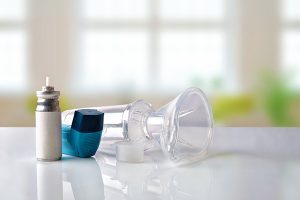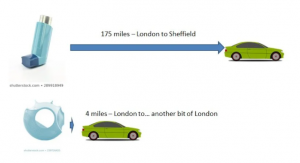Reducing the Carbon Footprint
Lawrence Hill Health Centre is committed to helping the NHS reach their target of being totally carbon neutral by 20401.
We are currently reviewing our own practices to look for changes we can make to help shape an environmentally friendly and sustainable future by reducing our carbon footprint.
One change that we have identified is reviewing our inhaler prescribing. Some inhalers are worse for the environment than others. So we would like to review the inhalers we are prescribing.
 What are metered dose inhalers and dry powder inhalers?
What are metered dose inhalers and dry powder inhalers?
Metered Dose Inhalers (MDIs) use a pressurised propellant within the aerosol chamber to help administer the medicine. The propellants used in these inhalers are potent greenhouse gases which cause damage to the ozone layer.
Dry Powder Inhalers (DPIs) are newer inhalers, where the medicine is released when the patient breathes in on the inhaler. This means that there is no need for the pressurised propellant.
Why are these inhaler changes important?
Inhalers contribute to roughly 3.5% of the NHS’ total carbon footprint2.
As mentioned, MDIs use greenhouse gases as their propellants. This means that, on average, 100 doses of an MDI releases carbon emissions equivalent to that released during a 180-mile drive in a car3. On the other hand, DPIs release 18 times LESS carbon emissions that MDIs4.
Climate change is also an important determinant of social and physical health5. In other words, reducing climate change will not only have a positive impact on the environment, but it will also improve our health in general.
What happens next?
At your next asthma or COPD review, the respiratory nurse will discuss any possible changes to your inhalers. Your health comes first, so changes will only happen if it is suitable for the patient.
We plan to review our ventolin prescribing. This is the most commonly used inhaler in the UK. Ventolin is actually the brand name (like hoover for vacuum cleaners), and the active ingredient is Salbutamol. Ventolin is a particularly large volume inhaler with lots of propellant in. Changing to a smaller volume metered dose inhaler, such as Salamol, means a lot less of the harmful propellant is released into the environment.
Find out more at Green Inhaler.
- NHS England. Delivering a ‘Net Zero’ National Health Service. https://www.england.nhs.uk/greenernhs/wp-content/uploads/sites/51/2020/10/delivering-a-net-zero-national-health-service.pdf (EXTERNAL LINK).
- NHS Sustainable Development Unit. Sustainable Development in the Health and Care System: Health Check;2016. https://www.sduhealth.org.uk/documents/publications/2016/20160310%20SDUupdate%20FINAL%20CR%20update.pdf (EXTERNAL LINK).
- NICE National Institute for Healthcare and Excellence: asthma patient decision aid. https://www.nice.org.uk/guidance/ng80/resources/inhalers-for-asthma-patient-decision-aid-pdf-6727144573
- British Thoracic Society (BTS) (2019) Position Statement: Environment and Lung Health. https://www.brit-thoracic.org.uk/document-library/governance-and-policy-documents/position-statements/environment-and-lung-health-position-statement-2019/
- Watts N, Amann M, Arnell A, et al. (2018). The 2018 report of the Lancet Countdown on health and climate change: shaping the health of nations for centuries to come. Lancet, 392(10163):2479–2514

